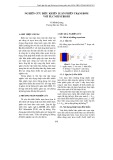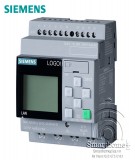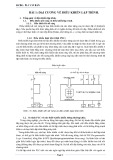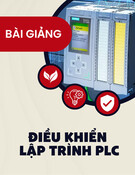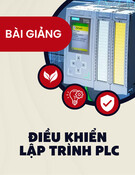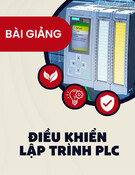
371
JOURNAL OF SCIENCE AND TECHNOLOGY DONG NAI TECHNOLOGY UNIVERSITY
Special Issue
IMPROVE SYSTEM STABILITY USING NEURAL HYBRID
CONTROLLER-PLC
Thanh Son Huynh, Hong Ngan Vo*
Dong Nai Technology University
*Corresponding author: Hong Ngan Vo, vohongngan@dntu.edu.vn
1. INTRODUCTION
With the continuous development of
society, the application of scientific research
results to industrial production has become
extremely important. Neural networks are not
a new topic and there are many studies and
applications in this field. However, the
development of a Neural-PLC (Programmable
Logic Controller) controller for industry is still
an essential need in the context of rapidly
developing industry in Vietnam. Currently,
Neural-PLC controllers used in some factories
in Vietnam are mainly copyrighted from the
manufacturer. Therefore, the goal of the study
is to apply knowledge of Neural networks
combined with PLC to design a Neural-PLC
controller in industry (Topalova & Tzokev,
2010); Ahmad & Prajitno, 2020). Traditional
PID controllers are notable for their simple
structure, easy adjustment, low cost and
effective response ability (Combaluzier et al.,
2016; Coelho et al., 2020). Meanwhile,
artificial neural networks can be considered as
a basic mathematical model of the brain,
operating as a distributed computing network
(Golenkov et al., 1992). Unlike traditional
computers, which need to be programmed to
perform specific tasks, most neural networks
require training (Wu & Feng, 2018). They are
capable of learning new connections,
functional relationships, and new patterns.
Neural networks are a fundamental tool for
developing intelligent systems that can learn.
One of the outstanding advantages of neural
GENERAL INFORMATION
ABSTRACT
Received date: 09/03/2024
This paper presents methods for controlling a real model
using the S7-400 controller with SCL language (Structured
Control Language). The two controllers designed are the
hybrid Neural Network Neural-PID (Proportional Integral
Derivative) controller and the RBF (Radial Basis Function)-
PID controller. The control results of the real model, a single
water tank, give quite good results, the errors in all cases are
small, and the overshoot is small. In the two cases above, the
system operates stably and the Neural-PID hybrid controller
gives the best results. The hybrid Neural-PID controller has
both the stability of a PID controller and the adaptive
learning of a Neural controller. Therefore, this method is
capable of controlling other models in industry such as
controlling weighing conveyors in the cement industry,
controlling heating systems, etc.
Revised date: 08/05/2024
Accepted date: 11/07/2024
KEYWORD
Neural;
PLC;
PID;
RBF;
SCL

JOURNAL OF SCIENCE AND TECHNOLOGY DONG NAI TECHNOLOGY UNIVERSITY
372
Special Issue
networks is their adaptability. Thanks to the
ability to automatically adjust weights, neural
networks can optimize operations such as
pattern recognition and system control
decision making. This adaptability allows
neural networks to maintain operating
efficiency when the environment and control
objects change over time (Grossberg, 2013).
Based on his own practical needs, the
author chose the research topic of building a
Neural controller in industry by building
functions in Siemens controllers. Using the
SCL language available in SIMATIC (Berger,
2012), the author studies the algorithms of
three controllers: PID controller (Al Gizi et al.,
2015), Neural controller (Alber et al., 2019),
RBF controller (Arora et al., 2014). Each
controller has different advantages and
disadvantages. To create different control
purposes, there are combinations of
advantages between PID and Neural network
into the hybrid control method Neural-PID
(Webb et al., 2011) and similar to the RBF-
PID controller (Ma et al., 2020). In this article,
the author will present two main controllers,
the Neural-PID controller and the RBF-PID
controller to control a real model of a single
water tank. The measurement results show that
both controllers operate stably, but the hybrid
Neural-PID controller gives the best response
control results, the errors in all cases are small,
and the overshoot is small.
2. OBJECTS AND METHODS
2.1. Research object
The control object is a single water tank
model as shown in Figure 1. A single water
tank is a nonlinear object, the water level
signal is often fluctuating (with interference),
so it is easy to simulate. Simatic manager
programming software is specialized for S7-
300 and S7-400 controllers, combined with
Omron's E4PA Ultrasonic Sensor, MM420
inverter and Redlion's industrial screen (Touch
Screen) to control the speed of the pump into
the water tank.
Using the SCL language available in
Simatic, the author researches two main
controllers: the Neural-PID controller and the
RBF-PID controller. Combining the
advantages of PID and Neural into a hybrid
Neural-PID control method and combining
RBF and PID into a hybrid RBF-PID control
method. The topic uses artificial neural
network technique combined with traditional
PID controller to design a controller with good
output response.
Figure 1. Water tank control model
2.2. Research method
The topic uses the experimental method to
find the optimal controller for the object here
is a single water tank. The author studies two
main controllers including the Neural-PID
controller and the RBF-PID controller. The
goal is that the controller must be stable,
sustainable, optimal, at the same time the cost
of use must be low and must be widely applied
in life. Experimental results show that the
hybrid Neural-PID controller controlling a
single water tank gives quite good results, with
small errors.

373
373
JOURNAL OF SCIENCE AND TECHNOLOGY DONG NAI TECHNOLOGY UNIVERSITY
Special Issue
3. SYSTEM DESIGN
3.1. Single water tank model
Consider a water tank system containing
liquid with a cross-section that varies with
height as shown in Figure 2 as follows:
Figure 2. Single Tank Model
The differential equation describing the
system is:
(1)
(2)
In which:
u(t)–pump control voltage (0 ≤ u(t) ≤ 10V)
h(t) – liquid level height in the tank (cm)
A(h) – cross-sectional area of the tank (cm2)
hmax – maximum height of the tank
Amax, Amin – maximum and minimum cross-
sectional areas
k – coefficient proportional to pump capacity
a – discharge valve cross-sectional area (cm2)
g – gravitational acceleration (981cm/sec2)
CD – discharge coefficient
Parameters of single water tank system are
as Table 1:
Table 1. Parameters of single water tank system
Parameter
Value
Maximum height, hmax (cm)
50
Maximum cross section, Amax (cm2)
100
Minimum cross section, Amin (cm2)
1
Proportional coefficient to pump
capacity, k (cm3/sec)
300
Exhaust valve cross section, a (cm2)
1
Discharge coefficient, CD
0.6
The problem is to control the liquid level
in the tank according to the set signal. From
the differential equation (1) above we have:
(3)
Subtracting h(t+1) we get:
(4)
Substituting the value of A(h) from
equation (2) we have:
(5)
Substituting the values of Amax, Amin, hmax,
k, CD, a, g, with sampling period t = 1s into
equation (5), we have:
(6)

JOURNAL OF SCIENCE AND TECHNOLOGY DONG NAI TECHNOLOGY UNIVERSITY
374
Special Issue
The single tank system is a nonlinear
system. In the simulation run, we will put this
mathematical equation into the object section.
When running with the real model, the object
will be the actual external tank. Here we have
one output that needs to be controlled, h(t+1)
and two input variables, u(t) and h(t).
3.2 Closed-loop numerical control system:
Figure 3. Closed-loop digital control system
The closed-loop digital control system is
shown in Figure 3. Through the K (symbolic)
keys working synchronously, the S7-400
controller reads the feedback signal from the
SM431 Module that has received the signal
from the water level sensor, compares it with
the signal set from the industrial screen, then
processes it according to two algorithms
Neural-PID, RBF-PID and outputs the control
signal. The control signal is transferred to the
SM432 analog signal output module to control
the object.
3.2.1 Neural-PID controller
(a)
(b)
Figure 4. Neural-PID controller: (a) Neural connection diagram, (b) Neural-PID control system
The Neural-PID controller has the stability
of the PID controller and the adaptive learning
of the Neural network (Yu & Rosen, 2013;
Rossomando & Soria, 2015). The Neural-PID
controller is a 3-layer feed-forward network:
an input layer, a hidden layer, and an output
layer. The input layer has 2 neurons that
receive signals from e and dt/de. The hidden
layer has 6 neurons, using a bipolar S-shaped
activation function. The output layer has 3
neurons, using a Sigmoid activation function.
The three outputs are responsible for adjusting
the 3 parameters KP, KI, KD respectively. All
neurons are connected together as shown in
Figure 4(a), 4(b).
: the input vector consists of
two neurons that receive signals from e and
de/dt.
: output of the q unit of the
hidden layer with l equal to 6.
: are the outputs of the output
layer with n equal to 3.

375
375
JOURNAL OF SCIENCE AND TECHNOLOGY DONG NAI TECHNOLOGY UNIVERSITY
Special Issue
: is the connection
weight between the input layer and the hidden
layer.
is the connection
weight between the hidden layer and the
output layer.
The weighted sum of the inputs to the qth
neuron in the hidden layer is:
(7)
The output signal of the qth neuron in the
hidden layer is:
(8)
The weighted sum of the input signals to
the ith neuron in the output layer is:
(9)
The output signal of the ith neuron in the
output layer is:
(10)
Suppose we have a training dataset
consisting of K samples (x(k), d(k)),
The criterion for training the network is to
minimize the error:
( 11)
The function E forms a convex surface in
space, on which there is a minimum point.
With any set of weights, we can calculate the
value of E on the convex surface.
The program of the Neural-PID controller
as shown in Figure 4 (b) is written using the
FC3 function in the SCL language. After
compiling the SCL program, the FC3 function
will be created in the Block of the program
according to the functions from (12) to (17).
Hidden layer activation function:
(12)
Output layer activation function:
(13)
Control law:
(14)
(15)
Discretization:
(16)
(17)
Combining the advantages of two Neural
and PID controllers gives us a hybrid Neural-
PID controller, the Neural-PID stabilizer has

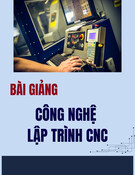

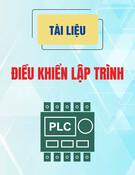
![Ngân hàng câu hỏi môn Điều khiển logic khả trình [chuẩn nhất]](https://cdn.tailieu.vn/images/document/thumbnail/2025/20250714/kimphuong1001/135x160/67121752467828.jpg)
